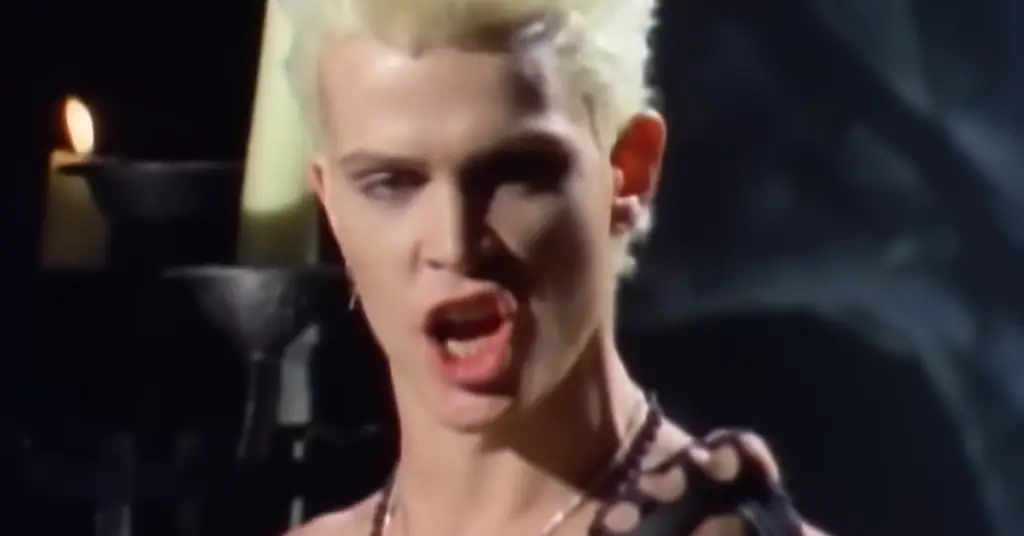Billy Idol – “White Wedding”: A Snarl, A Sneer, and a Synth-Punk Classic
Released in 1982 on his self-titled debut album, “White Wedding” is the song that launched Billy Idol into the American mainstream, combining punk swagger, gothic romance, and a sound that was unmistakably ‘80s. With its pulsing rhythm, seething vocals, and iconic music video, the track became an MTV staple and a defining anthem of Idol’s leather-clad, sneering persona.
But beyond the gothic edge and fist-pumping chorus lies a track that’s far more complex — a dark take on love, conformity, and rebellion.
The Sound: Punk Rock Meets Synth-Driven Drama
“White Wedding” fuses punk’s raw attitude with the emerging sounds of new wave and hard rock. It features:
- A chugging, menacing guitar riff, courtesy of long-time collaborator Steve Stevens
- Synthesizer textures that add eerie tension and cinematic flair
- A slow build, from whisper to scream, making the eventual chorus hit like a thunderclap
- Billy Idol’s snarling vocal, walking the line between seductive and sinister
It’s moody, infectious, and uniquely theatrical — the kind of track that feels equally at home on a dance floor or blasting out of a muscle car.
The Lyrics: A Bitter Toast to Tradition
“Hey little sister, what have you done?”
The lyrics of “White Wedding” aren’t celebrating holy matrimony — they’re critiquing it. Idol has said the song was partly inspired by his real-life frustration that his sister was getting married while pregnant, and he felt she was conforming to societal expectations. But instead of taking a direct stance, the lyrics simmer with mockery, jealousy, and disillusionment.
“It’s a nice day to start again…”
That famous line flips the script — not just about weddings, but about second chances, reinvention, and rebellion. The repeated refrain “start again” suggests Idol’s character is longing to rewrite his story — or hers — outside the confines of tradition.
It’s a love song twisted into a warning, and that complexity has kept it compelling for decades.
The Music Video: A Gothic MTV Milestone
Directed by David Mallet, the music video for “White Wedding” became an instant MTV hit. With its gothic church setting, leather-clad bikers, ring of fire, and Idol’s menacing stare, it was both surreal and unforgettable.
- The scene of a wedding veil being ripped off and the bride’s dress torn away was controversial, but iconic
- Idol’s intense stare into the camera helped define his “bad boy” persona
- The video’s theatricality made it a template for many ‘80s rock videos, blending fashion, rebellion, and performance art
MTV’s heavy rotation of the video helped push the song up the charts, especially in the U.S., where Idol became a household name almost overnight.
Chart Performance & Cultural Impact
While “White Wedding” wasn’t a huge hit at first, it became a slow-burning classic:
- Peaked at #36 on the Billboard Hot 100
- Reached #6 on the UK Singles Chart
- Became one of Idol’s signature songs, alongside “Rebel Yell” and “Dancing With Myself”
- Frequently appears in movies, TV, and video games, from The Wedding Singer to Guitar Hero
Today, it’s recognized as a cornerstone of ‘80s rock, thanks to its visual style, infectious chorus, and enduring snarl.
Legacy: The Ultimate Anti-Wedding Anthem
Ironically, “White Wedding” has become a popular wedding song — often played with a wink, as a nod to nonconformity. But at its core, the track is about rejecting expectations, tearing down rituals, and finding your own voice in a world of rules.
It’s not really about the perfect ceremony — it’s about starting over, breaking free, and doing it your own way.

Final Thoughts
“White Wedding” is Billy Idol at his finest — part rock star, part rebel, all attitude. It’s a song that fuses fury and fun, irony and intensity. Whether you hear it as a middle finger to tradition or a darkly seductive anthem of second chances, one thing’s for sure:
It’s a nice day to start again.


Facebook Comments